Height 6 ft 0 in (183 cm) Position Right Wing Name Gordie Howe | Shot Ambidextrous Role Ice hockey player Career start 1946, 1973 | |
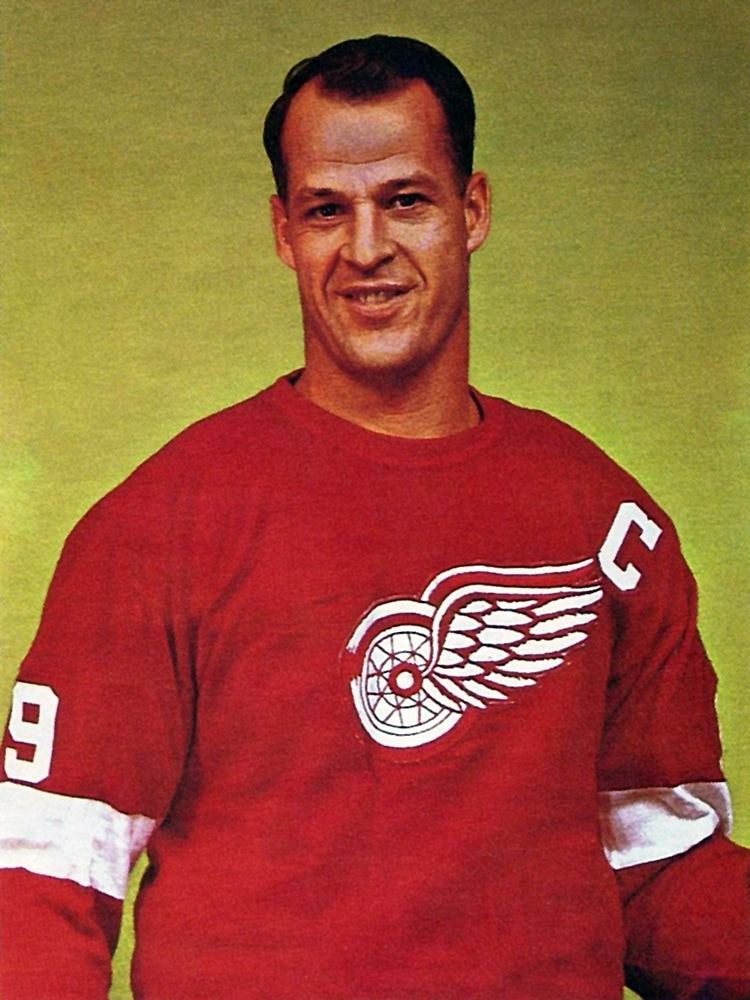 | ||
Born March 31, 1928 (age 97) Floral, SK, CAN ( 1928-03-31 ) Weight 205 lb (93 kg; 14 st 9 lb) Children Mark Howe, Marty Howe, Cathy Howe, Murray Howe Played for United States Hockey League Books Mr. Hockey: My Story, After the Applause, Let's play hockey Similar People | ||
Playing career | ||
Gordie howe wiki videos
Gordon "Gordie" Howe, OC (March 31, 1928 – June 10, 2016) was a Canadian professional ice hockey player. From 1946 to 1980, he played twenty-six seasons in the National Hockey League (NHL) and six seasons in the World Hockey Association (WHA); his first 25 seasons were spent with the Detroit Red Wings. Nicknamed "Mr. Hockey", Howe is considered the most complete player to ever play the game and one of the greatest ice hockey players of all time. A 23-time NHL All-Star, he held many of the sport's career scoring records until they were broken in the 1980s by Wayne Gretzky, who himself has been a major champion of Howe's legacy. He continues to hold NHL records for most games and seasons played. In 2017, Howe was named one of the "100 Greatest NHL Players".
Contents
- Gordie howe wiki videos
- Wayne gretzky remembers gordie howe conan on tbs
- Early life
- Playing career
- Detroit Red Wings
- World Hockey Association
- 1974 Summit Series
- Hartford Whalers
- Legacy
- Retirement
- Personal life and death
- Honours
- Professional career statistics
- Records
- References
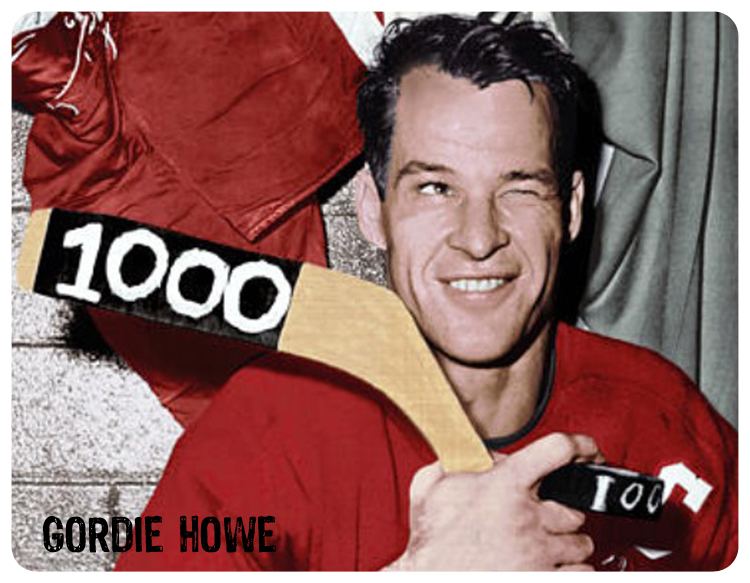
Howe was recruited by the Red Wings and made his NHL debut in 1946. He won the Art Ross Trophy for leading the league in scoring each year from 1950-51 to 1953-54, then again in 1956-57 and 1962–63, a total of six times, the second most in NHL history. He led the league in goal scoring four times. He ranked among the top ten in league scoring for 21 consecutive years and set a league record for points in a season (95) in 1953, a record which was broken six years later. He won the Stanley Cup with the Red Wings four times and won six Hart Trophies as the league's most valuable player. He also led the NHL playoffs in points six times, but there was no Conn Smythe Trophy recognizing the most valuable player in the playoffs until the latter part of his career (1965), well after Detroit had won its four Stanley Cups with Howe.
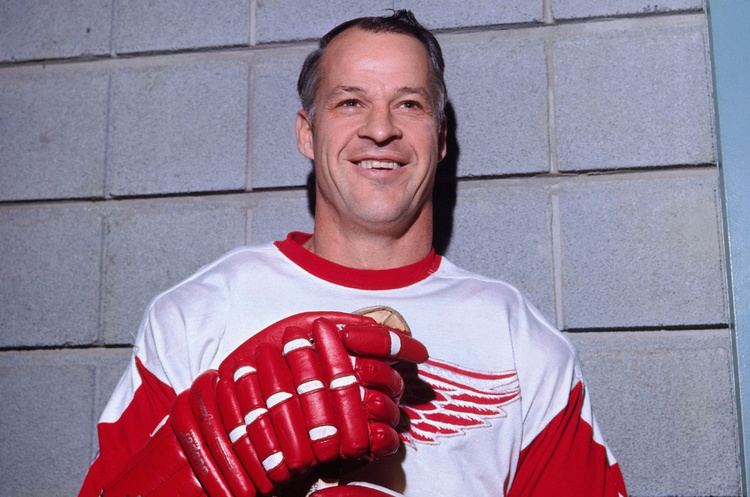
Howe retired for the first time in 1971 and was immediately inducted into the Saskatchewan Sports Hall of Fame that same year. He was then inducted into the Hockey Hall of Fame the next year. However, he came back two years later to join his sons Mark and Marty on the Houston Aeros of the WHA. Although in his mid-40s, he scored over 100 points twice in six years, although it's recognized that goal scoring was approximately 25% higher in the WHA than in the NHL. He made a brief return to the NHL in 1979–80, playing one season with the Hartford Whalers, then retired at the age of 52. His involvement with the WHA was central to their brief pre-NHL merger success and forced the NHL to expand their recruitment to European talent and to expand to new markets.
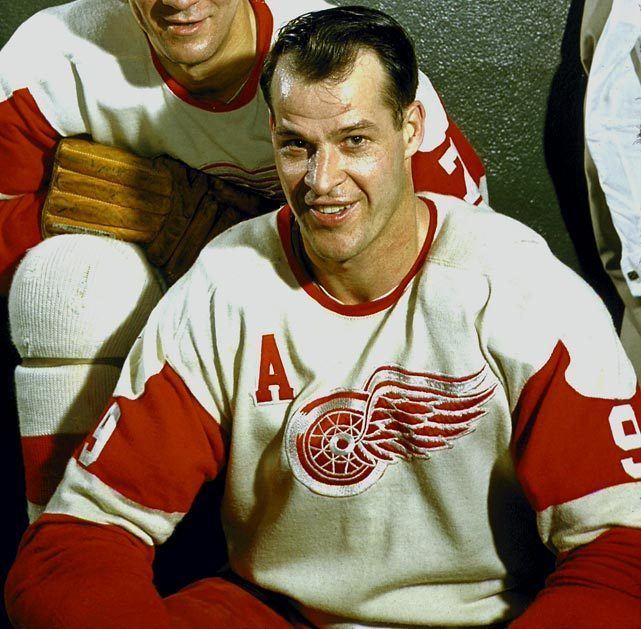
Howe was most famous for his scoring prowess, physical strength, and career longevity, and redefined the ideal qualities of a forward. He is the only player to have competed in the NHL in five different decades (1940s through 1980s). Although he only achieved the feat twice in his own career, he became the namesake of the "Gordie Howe hat trick": a goal, an assist, and a fight in the same game. He was the inaugural recipient of the NHL Lifetime Achievement Award in 2008.
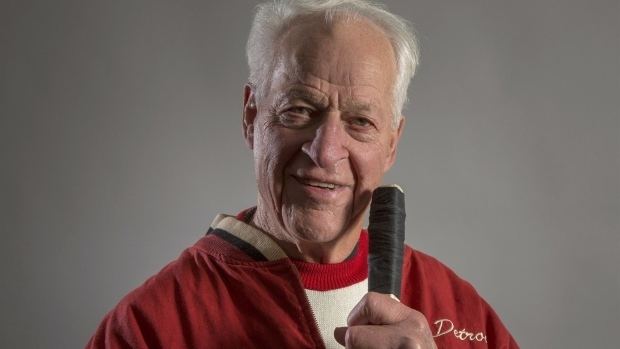
Wayne gretzky remembers gordie howe conan on tbs
Early life
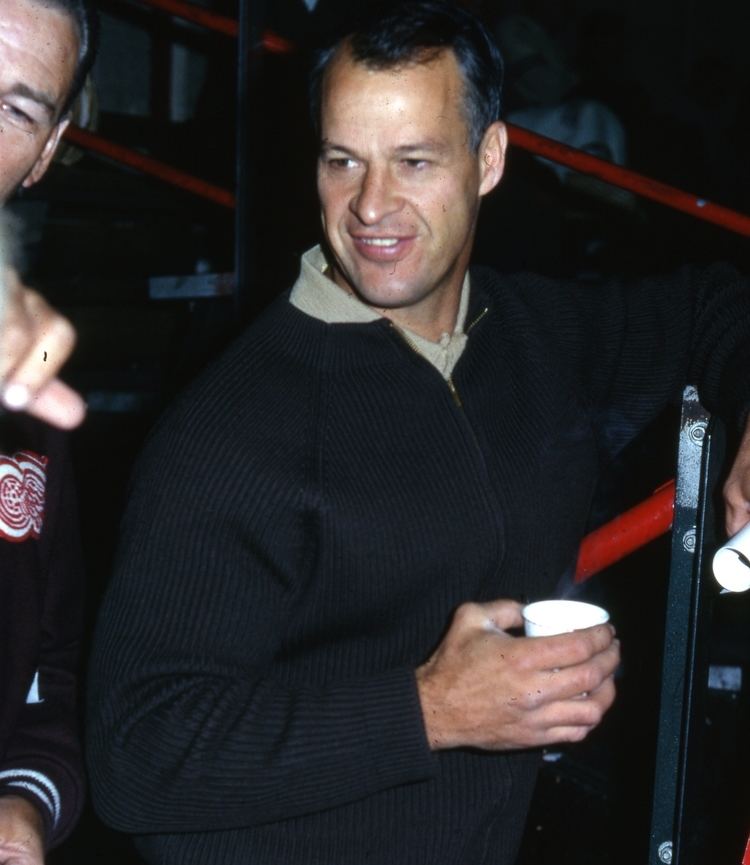
Howe was born in a farmhouse in Floral, Saskatchewan, the son of Katherine (Schultz) and Albert Howe. He was one of nine siblings. When Gordie was nine days old, the Howes moved to Saskatoon, where his father worked as a labourer during the Depression. In the summers, Howe would work construction with his father.
He was mildly dyslexic growing up, but was physically beyond his years at an early age. Already six feet tall in his mid-teens, doctors feared a calcium deficiency and encouraged him to strengthen his spine with chin-ups. He began playing organized hockey at eight years old. Howe quit school during the Depression to work in construction, then left Saskatoon at sixteen to pursue his hockey career.
Playing career
Howe was an ambidextrous player, one of just a few skaters able to use the straight sticks of his era to shoot either left- or right-handed. As a young teen Howe played bantam hockey with the King George Athletic Club in his hometown of Saskatoon, winning his first championship with them in the 1942 Saskatchewan Provincial Bantam Hockey Finals. He received his first taste of professional hockey at age 15 in 1943 when he was invited by the New York Rangers to their training camp held at "The Amphitheatre" in Winnipeg, Manitoba. He played well enough there that the Rangers wanted Howe to sign a "C" form which would have given that club his NHL rights and to play that year at Notre Dame, a Catholic school in Wilcox, Saskatchewan, that was known for turning out good hockey players. Howe did not feel that was a good fit for him and wanted to go back home to play hockey with his friends, and declined the Rangers' offer and returned to Saskatoon.
In 1944, Howe was noticed by Detroit Red Wings scout Fred Pinkney and was invited to their camp in Windsor, Ontario. He was signed by the Red Wings to a "C" form and assigned to their junior team, the Galt Red Wings. However, due to a maximum number of Western players allowed by the league and the Red Wings' preference to develop older players, Howe's playing time with the team was initially limited. In 1945, however, he was promoted to the Omaha Knights of the minor professional United States Hockey League (USHL), where he scored 48 points in 51 games as a seventeen-year-old. While playing in Omaha, Frank Selke of the Toronto Maple Leafs organization noticed that Howe was not properly listed as Red Wings property. Having a good relationship with Detroit coach Jack Adams, he notified Adams of the clerical error and Howe was quickly put on the team's protected list.
Detroit Red Wings
Howe made his NHL debut on October 16, 1946, playing right wing for the Detroit Red Wings, scoring in his first game at the age of 18. He wore #17 as a rookie. However, when Roy Conacher moved on to the Chicago Black Hawks after the 1946–47 season, Howe was offered Conacher's #9, which he would wear for the rest of his career; although he had not requested the change, Howe accepted it when he was informed that "9" would entitle him to a lower Pullman berth on road trips. He quickly established himself as a great goalscorer and a gifted playmaker with a willingness to fight. Howe fought so often in his rookie season that coach Jack Adams told him, "I know you can fight. Now can you show me you can play hockey?" The term "Gordie Howe hat trick" (consisting of a goal, an assist, and a fight) was coined in reference to his penchant for fighting; however, Howe himself only recorded two such hat tricks in his career, on October 10, 1953 and March 21, 1954. Using his great physical strength, he was able to dominate the opposition in a career that spanned six decades (including one game with the Detroit Vipers of the IHL in 1997). In a feat unsurpassed by any hockey player, he finished in the top five in scoring for 20 straight seasons. Howe also scored 20 or more goals in 22 consecutive seasons between 1949 and 1971, an NHL record.
Howe led Detroit to four Stanley Cup championships and to first place in regular season play for seven consecutive years (1948–49 to 1954–55), a feat never equalled in NHL history. During this time, Howe and his linemates, Sid Abel and Ted Lindsay, were known collectively as "The Production Line", both for their scoring and as an allusion to Detroit auto factories. The trio dominated the league in such a fashion that in 1949–50, they finished one-two-three in league scoring. Howe's prime was during a defensive era, the 1940s and 1950s, when scoring was difficult and checking was tight.
As he was emerging as one of the top players in the league, however, Howe sustained the worst injury of his career, fracturing his skull after an attempt to check Toronto Maple Leafs captain Ted Kennedy into the boards went awry during the 1950 playoffs. The severity of the fracture was such that he was taken to the hospital for emergency surgery in order to relieve building pressure on his brain. He ended up missing the rest of the playoffs, but his dominant team-mates were still able to win the Stanley Cup.
The next season (1950–51), he returned to record 86 points, winning the scoring title by 20 points. That was the first year of a four-year period of dominance by Howe which the NHL had never seen before. Howe won four straight scoring titles and in two of the years (1950–51 and 1952–53) Howe led the league in both goals and assists, which has only been done by five other players in history (a total of 10 times aside from Howe). In three of those years he led the league in goals. In the 1952–53 Howe became the first NHL player to score 90 points, finishing the season with 95 points and a career-best 49 goals which just missed tying the league record of 50 goals held by Rocket Richard (albeit in a 50-game season). Prior to Howe, no NHLer had led the league in points more than two times in a row. Only three other players have ever matched the feat of winning four straight scoring titles since - Phil Esposito, Jaromir Jagr and Wayne Gretzky (who won seven in a row).
As Howe emerged as one of the game's superstars, he was frequently compared to the Montreal Canadiens' Maurice "Rocket" Richard. Both were right wingers who wore the number 9, and were contenders for the league scoring title, and could also play rough if needed. The Red Wings and Canadiens faced off in four Stanley Cup finals during the 1950s.
The Red Wings were consistent contenders throughout the 1950s and early 1960s but began to slump in the late 1960s. When Howe turned 40 in 1967–68, the league expanded from six to 12 teams and the number of scoring opportunities grew as the game schedule increased. Howe played the 1968–69 season on a line with Alex Delvecchio and Frank Mahovlich. Mahovlich was big, fast, and skilled, and Delvecchio was a gifted playmaker. The three were dubbed "The Production Line 3" and at 40 years old, Howe scored 103 points, breaking in 100 points for the only time in his NHL career by scoring 44 goals and a career-high 59 assists.
Following his personal best 103-point season, however, conflict with the Red Wings organization arose after Howe discovered he was just the third-highest paid player on the team with a $45,000 salary. Furthermore, while owner Bruce Norris increased Howe's salary to $100,000, he blamed Howe's wife, Colleen, for the demand. Howe remained with the Red Wings for two more seasons, but after 25 years, a chronic wrist problem forced him to retire after the 1970–71 season and he took a job in the Red Wings front office. At the beginning of 1972, he was offered the job as first head coach of the New York Islanders, but turned it down. By the end of his NHL career, Howe had won the Hart Memorial Trophy as the NHL Most Valuable Player six times: 1952, 1953, 1957, 1958, 1960, and 1963—at that time the most of any player, and as of 2016 second only to Gretzky's nine. He also finished second or third in the voting for the Hart a further six times. Howe was named to the NHL's First All-Star Team 12 times and to the Second All-Star Team eight times.
Howe was named an Officer of the Order of Canada in 1971. His number 9 jersey was retired by the Red Wings on March 12, 1972.
World Hockey Association
A year later, Howe was offered a contract to play with the Houston Aeros of the newly formed World Hockey Association (WHA), who had also signed his sons Mark and Marty to contracts. Dissatisfied with not having any meaningful influence in the Red Wings' office, he underwent an operation to improve his wrist and make a return to hockey possible, and he led his new team to consecutive championships. In 1974, at the age of 46, Howe won the Gary L. Davidson Trophy, awarded to the WHA's Most Valuable Player (the trophy was renamed the Gordie Howe Trophy the following year). Howe played with the Aeros until 1977, when he and his sons joined the New England Whalers.
1974 Summit Series
Gordie was named with sons Mark and Marty to the WHA version of Team Canada for an eight-game series against the USSR National team. Playing on a line with son Mark and Ralph Backstrom, Gordie contributed 7 points in 7 games at age 46. USSR won the series four wins to Canada's one, and with three ties.
In the final season of the WHA, Gordie had the opportunity to play with Wayne Gretzky in the 1979 WHA All-Star Game. The format of the game was a three-game series between the WHA All-Stars against HC Dynamo Moscow. The WHA All-Stars were coached by Jacques Demers, and Demers asked Howe if it was okay to put him on a line with Gretzky and his son Mark. In Game One, the line scored seven points, as the WHA All-Stars won by a score of 4–2. In Game Two, Gretzky and Mark Howe each scored a goal and Gordie Howe picked up an assist as the WHA won 4–2. WHA also won Game Three to ensure a clean sweep.
Hartford Whalers
When the WHA folded in 1979, the renamed Hartford Whalers joined the NHL. While the Red Wings still held his NHL rights even though he had retired eight years earlier, the Whalers and Red Wings reached a gentleman's agreement in which the Red Wings agreed not to reclaim him. Howe had experienced dizzy spells in the late part of the 1978–79 WHA season, and underwent an "extensive battery of tests" before making his decision to play the 1979–80 season. The 51/52-year-old Howe played one final season appearing in all 80 games of the schedule and helping his team to make the playoffs by scoring 41 points – 15 goals and 26 assists. Late in the season the Whalers signed Bobby Hull and put Howe-Hull and Dave Keon on the same line. One particular honour was when Howe, Phil Esposito and Jean Ratelle were selected to the mid-season All-Star Game—which was to take place in Detroit—by coach Scotty Bowman, as a nod to their storied careers before they retired. Howe had played in five decades of All-Star Games and he would skate alongside the second-youngest to ever play in an All-Star Game, 19-year-old Wayne Gretzky. The Joe Louis Arena crowd gave him a standing ovation twice, lasting so long that he had to skate to the bench to stop people from cheering. He had one assist in the Wales Conference's 6–3 win.
Legacy
Howe's name and nickname, "Mr. Hockey", as well as his late wife's nickname as "Mrs. Hockey", are registered trademarks. Howe was also referred to during his career as Power, Mr. Everything, Mr. All-Star, The Most, The Great Gordie, The King of Hockey, The Legend, The Man, No. 9, and "Mr. Elbows" (for his tough physical play). Howe was widely considered the most complete player in all of hockey history. Once Howe began dominating the league, NHL scouts were given new directives to discover players that played the way he did. Howe's strength, scoring ability, and speed exemplified the perfect example of the modern-day role of a power forward and someone who can play the 200-foot game.
Howe's brawn and physical play inspired the coining of "The Gordie Howe Hat Trick"—a goal, an assist and a fight—which is now a standard part of hockey's vocabulary. Ironically, Howe himself only achieved his namesake hat trick twice in his long career, because few players dared to fight him after Howe soundly defeated New York Rangers enforcer Lou Fontinato at Madison Square Garden in 1959. However, Howe was known for being a well-mannered and trusting person off the ice who never questioned the salary the Detroit Red Wings owners paid him. When it became public knowledge that Howe had scored more than 600 goals for the organization before it deigned to pay him over $40,000, his linemate, Ted Lindsay, began a campaign to establish a player's association to unite for fair wages against the NHL owners. This would be the nucleus of the movement that became the National Hockey League Players' Association.
Howe's time playing with the World Hockey Association with his sons allowed the fledgling professional league to gain much-needed legitimacy and the ability to fill stadiums. The increased competition for hockey talent forced the insular NHL to seek players beyond its traditional North American sources and recruit professional European players and to expand into new cities to gain new fans. Wayne Gretzky was one of the players who elected to go to the WHA instead of the NHL. Over the years, Howe became good friends with Gretzky, who had idolized him as a young player and who would later break many of Howe's scoring records and milestones. While Gretzky surpassed Howe statistically, it was Howe who had first set the standard for consistent, high-level play. Howe's number 9 has been both directly and indirectly worn by two of the all-time greats as a tribute to him; Gretzky wore number 99 as a direct tribute to Howe since 9 was taken during the early parts of his career while Mario Lemieux wore number 66 because it was upside-down of Gretzky's 99.
Another milestone was reached in 1997 when Howe played professional hockey in a sixth decade. He was signed to a one-game contract by the Detroit Vipers of the IHL and, at 69 years old, made a return to the ice for one shift. In doing so, he became the only player in hockey history to compete in six different decades at the professional level, having played in the NHL, WHA and IHL from the 1940s to 1990s.
Howe's first 20 seasons came during an era when the schedule was only 70 games, scoring was difficult, and checking was tight; he never scored 50 goals in a single season. Despite that Howe is currently 4th on the NHL's all-time points list with 1850 total points 801 goals, and 1049 assists, after Gretzky, Mark Messier, and Jaromír Jágr. Howe is still 2nd on the all-time goals list, with only Gretzky ahead of him. When career regular season goals from both the NHL and the WHA are combined, he ranks first in goals with 975, ahead of Gretzky's 940.
At the time of his retirement, Howe's professional totals, including playoffs, for the NHL and WHA combined, were first. He finished with 2,421 games played, 1,071 goals, 1,518 assists, and 2,589 points. Later on, however, Wayne Gretzky would pass him in goals (1,072), assists (2,297), and points (3,369), but not in games played or games played with one team. After Howe's death, Gretzky called Howe "the greatest hockey player ever."
Howe played internationally on one occasion, at the 1974 Summit Series.
In the 1986 film Ferris Bueller's Day Off, the title character's best friend wears Howe's Detroit Red Wings jersey throughout most of the film, even though it is set in Chicago. Howe had provided one to the filmmakers personally.
In May 2015, Canadian Prime Minister Stephen Harper and Michigan Governor Rick Snyder announced that a new international bridge spanning the Detroit River would be named in honour of Howe. The Gordie Howe International Bridge is set to open in 2020. On June 27, 2016, it was announced that a bridge in his hometown of Saskatoon would be named after Howe. He was awarded the Order of Canada by the Governor General of Canada, Queen Elizabeth II's representative in the country.
Retirement
Howe was named to Canada's Sports Hall of Fame in 1975. In 1998, The Hockey News released their List of Top 100 NHL Players of All Time and listed Howe third overall, behind Wayne Gretzky and Bobby Orr. Of the list, Orr was quoted as regarding Howe as the greatest player. In 2000, Howe was inducted into Canada's Walk of Fame.
On April 10, 2007, Howe was honoured with the unveiling of a new bronze statue in Joe Louis Arena, where the West Entrance is named the "Gordie Howe Entrance" in his honour. The statue is 12 feet (3.7 m) tall and weighs about 4,500 pounds (2,000 kg). The statue contains all of Howe's stats and history. Another statue of Howe was erected in downtown Saskatoon, Saskatchewan, on the corner of 20th Street and 1st Ave. He is depicted wearing a Detroit Red Wings sweater. The statue has since been relocated to the SaskTel Centre.
In February 2011, various groups proposed naming the New International Trade Crossing bridge, a proposed bridge that will connect Detroit and Windsor by linking Highway 401 in Ontario with Interstate 75 and Interstate 94 in Michigan, in honour of Howe. On May 14, 2015, during an event attended by Canadian Prime Minister Stephen Harper, it was officially announced that the bridge would be known as the Gordie Howe International Bridge.
Canadian actor Michael Shanks portrayed Howe in the Hallmark movie Mr. Hockey: The Gordie Howe Story. The film aired April 28, 2013, on CBC and on the Hallmark Channel in the US on May 5.
After the death of his wife, Colleen Howe in 2009, Howe turned his charitable activity towards degenerative diseases such as dementia and Alzheimer's, and founded the Gordie and Colleen Howe Fund for Alzheimer's, in partnership with the University of Toronto's aging and brain health facility at Baycrest.
Personal life and death
Howe met his wife, Colleen (née Joffa), at a bowling alley when she was 17 years old, and they were married four years later on April 15, 1953. A middle school in Abbotsford, British Columbia, is named after Gordie and Colleen Howe, and a traffic bridge, campground, and football stadium are named after Gordie Howe in his hometown of Saskatoon, Saskatchewan. Two of their sons, Marty and Mark, were his teammates on the WHA Houston Aeros and the New England (WHA)/Hartford (NHL) Whalers. Mark had a long NHL career, playing 16 seasons for the Hartford Whalers, the Philadelphia Flyers, and the Red Wings, and was one of the dominant two-way defencemen of the 1980s. He followed his father by being elected to the Hockey Hall of Fame in 2011. Their third son, Murray, is a radiologist in Toledo, Ohio, and only daughter, Cathy, lives in Lubbock, Texas.
Colleen Howe was one of the founders of the Detroit Junior Red Wings and represented both Gordie and Mark financially during their careers. She died in 2009 at age 76 after a long battle with Pick's disease.
Howe's younger brother, Vic Howe, also played in the NHL appearing in 33 games with the New York Rangers between 1950 and 1955. Vic died at age 85 in Moncton, New Brunswick, on January 31, 2015.
Due to dementia, Howe spent most of his time after his wife's death residing with all four of his children on a rotating basis. While staying at his daughter's home in Texas, he had a major stroke on October 26, 2014. He died on June 10, 2016, at his son Murray's house in Sylvania, Ohio, a suburb of Toledo, at the age of 88. No cause was given. Howe's casket was brought to Joe Louis Arena, the home of the Detroit Red Wings, for a public visitation on June 14, 2016 that lasted from 9 a.m. to 9 p.m. in honour of the No. 9 that Howe wore on his jersey. Wayne Gretzky, Scotty Bowman and Detroit Tigers great Al Kaline acted as pallbearers at the event. Howe's funeral, which was also opened to the public, was held on June 15, 2016 at Detroit's Cathedral of the Most Blessed Sacrament. Howe's cremated remains, along with those of his wife Colleen, were interred in Saskatoon in September 2016, at the base of his statue outside of SaskTel Centre.
Honours
Professional career statistics
GP = Games played; G = Goals; A = Assists; Pts = Points; PIM = Penalty minutes
* Stanley Cup Champion; ** AVCO Cup Champion
Bolded means led league
